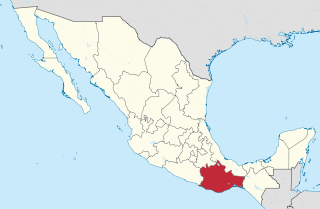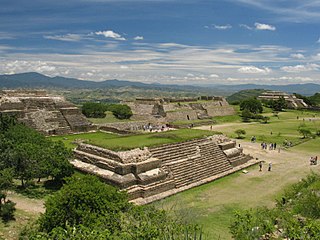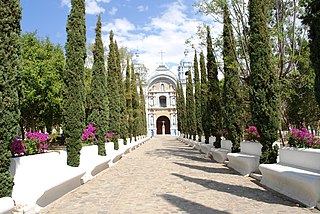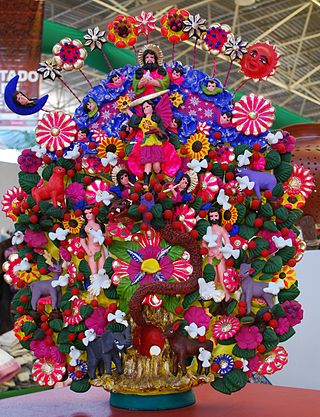
Oaxaca, officially the Free and Sovereign State of Oaxaca, is one of the 32 states that compose the Federative Entities of the United Mexican States. It is divided into 570 municipalities, of which 418 are governed by the system of usos y costumbres with recognized local forms of self-governance. Its capital city is Oaxaca de Juárez.

Oaxaca de Juárez, or simply Oaxaca, is the capital and largest city of the eponymous Mexican state of Oaxaca. It is the municipal seat for the surrounding municipality of Oaxaca. It is in the Centro District in the Central Valleys region of the state, in the foothills of the Sierra Madre at the base of the Cerro del Fortín, extending to the banks of the Atoyac River.

Tourism in Mexico is a very important industry. Since the 1960s, it has been heavily promoted by the Mexican government, as "an industry without smokestacks." Mexico has traditionally been among the most visited countries in the world according to the World Tourism Organization, and it is the second-most visited country in the Americas, after the United States. In 2017, Mexico was ranked as the sixth-most visited country in the world for tourism activities. Mexico has a significant number of UNESCO World Heritage Sites, with the list including ancient ruins, colonial cities, and natural reserves, as well as a number of works of modern public and private architecture. Mexico has attracted foreign visitors beginning in the early nineteenth century, with its cultural festivals, colonial cities, nature reserves and the beach resorts. The nation's temperate climate and unique culture – a fusion of the European and the Mesoamerican – are attractive to tourists. The peak tourism seasons in the country are during December and the mid-Summer, with brief surges during the week before Easter and Spring break, when many of the beach resort sites become popular destinations for college students from the United States.

San Pablo Villa de Mitla is a town and municipality in Mexico which is most famous for being the site of the Mitla archeological ruins. It is part of the Tlacolula District in the east of the Valles Centrales Region. The town is also known for its handcrafted textiles, especially embroidered pieces and mezcal. The town also contains a museum which was closed without explanation in 1995, since when its entire collection of Zapotec and Mixtec cultural items has disappeared. The name “San Pablo” is in honor of Saint Paul, and “Mitla” is a hispanization of the Nahuatl name “Mictlán.” This is the name the Aztecs gave the old pre-Hispanic city before the Spanish arrived and means “land of the dead.” It is located in the Central Valleys regions of Oaxaca, 46 km from the city of Oaxaca, in the District of Tlacolula.

Barro negro pottery is a style of pottery from Oaxaca, Mexico, distinguished by its color, sheen and unique designs. Oaxaca is one of few Mexican states which is characterized by the continuance of its ancestral crafts, which are still used in everyday life. Barro negro is one of several pottery traditions in the state, which also include the glazed green pieces of Santa María Atzompa; however, barro negro is one of the best known and most identified with the state. It is also one of the most popular styles of pottery in Mexico. The origins of this pottery style extends as far back as the Monte Albán period. For almost all of this pottery's history, it had been available only in a grayish matte finish. In the 1950s, a potter named Doña Rosa devised a way to put a black metallic-like sheen onto the pottery by polishing it before firing. This look has increased the style's popularity. From the 1980s to the present, an artisan named Carlomagno Pedro Martínez has promoted items made this way with barro negro sculptures which have been exhibited in a number of countries.

Ocotlán de Morelos is a town and municipality in the state of Oaxaca, about 35 km south of the center of the city of Oaxaca along Highway 175. It is part of the Ocotlán District in the south of the Valles Centrales Region. The area was a significant population center at the time of the Spanish Conquest, and for that reason an important Dominican monastery was established here in the 16th century. The complex still exists, with the church still being used for worship and the cloister area used as a museum. While mostly quiet, the city is an important distribution and transportation center for the south of the Central Valleys region of Oaxaca, a function which is expected to be reinforced with the opening of new highway being built to connect the city of Oaxaca with the Pacific coast. The city is known for artist Rodolfo Morales, who painted aspects of his hometown in his works and sponsored projects to save and restore historic monuments here. For generations the municipality has been known for its crafts, with the ceramics making Aguilar family producing some of the best known craftsmen.
Demián Flores Cortés is a contemporary Mexican artist who works in multiple media. He has worked in graphic arts, painting, serigraphy and more producing work which often mixes images from his rural childhood home of Juchitán with those related to modern Mexico City. It also often including the mixture of pop culture images with those iconic of Mexico’s past. Much of Flores’ work has been associated with two artists’ workshops he founded in Oaxaca called La Curtiduría and the Taller Gráfica Actual. This work has included events related to the 2006 uprising in Oaxaca and the restoration of an 18th-century church. His work has been exhibited in Mexico City, Europe, Guatemala and Cuba.

Santa María Atzompa is a town and municipality located in the Mexican state of Oaxaca, about five km from the state capital of Oaxaca. It is part of the Centro District in the Valles Centrales region. The town was founded between the 7th and 9th centuries as a satellite of the ancient Zapotec city of Monte Albán. Since its founding, pottery making has been a major economic activity and the town is currently known for its green-glazed pottery. This pottery used to be shipped all over Mexico and exported to the United States but today most of this pottery is sold locally. Beginning in 2009, there has been excavation at the Atzompa archeological site, leading to the discovery of a 45-meter Mesoamerican ball court, which has been determined to have been on the principal one for Monte Alban. Today, the town is rustic with the smoke of wood-fired pottery kilns ever present. Poverty has been a concern for the town, but innovations such as the use of lead-free glazing and a communal crafts market have been implemented to improve the craft's prospects.

Green glazed pottery of Atzompa is a style of glazed pottery, which originates in the Oaxaca, Mexico town of Santa María Atzompa. Almost all of the pottery made here is of a jade-green color, due to the lead monoxide glaze which has been traditionally applied to it.

Ceramics in Mexico date back thousands of years before the Pre-Columbian period, when ceramic arts and pottery crafts developed with the first advanced civilizations and cultures of Mesoamerica. With one exception, pre-Hispanic wares were not glazed, but rather burnished and painted with colored fine clay slips. The potter's wheel was unknown as well; pieces were shaped by molding, coiling and other methods,
According to the Mexican government agency Conapo, Oaxaca is the third most economically marginalized states in Mexico. The state has 3.3% of the population but produces only 1.5% of the GNP. The main reason for this is the lack of infrastructure and education, especially in the interior of the state outside of the capital. Eighty percent of the state's municipalities do not meet federal minimums for housing and education. Most development projects are planned for the capital and the surrounding area. Little has been planned for the very rural areas and the state lacks the resources to implement them. The largest sector of Oaxaca's economy is agriculture, mostly done communally in ejidos or similar arrangements. About 31% of the population is employed in agriculture, about 50% in commerce and services and 22% in industry. The commerce sector dominates the gross domestic product at 65.4%, followed by industry/mining at 18.9% and agriculture at 15.7%.

The Museo Estatal de Arte Popular de Oaxaca or MEAPO is a small museum in the municipality of San Bartolo Coyotepec just south of the city of Oaxaca in Mexico. It is run by the state of Oaxaca to showcase the entity's handcrafts and folk art tradition, through its permanent collection, online "cyber-museum", collaboration with national and international entities, and sponsorship of events such as craft markets, conferences, and temporary exhibitions. It is dedicated to the crafts and to the artisans and the cultures behind the items. Its collection contains samples of most of the crafts produced in the state, especially the Central Valleys region, but most of its collection consists of barro negro pottery, the specialty of San Bartolo Coyotepec. It is run by director Carlomagno Pedro Martínez, a recognized artisan and artist in barro negro.

Museo Universitario de Artes Populares María Teresa Pomar is a museum dedicated to Mexico's handcrafts and folk art tradition, called “artesanía.” It is part of the University of Colima in the city of Colima, founded by artesanía collector and promoter María Terea Pomar. It contains one of the most important collections of its type in Mexico, covering traditions from around the country as well as the artesanía and traditions of the state of Colima.

Carlomagno Pedro Martínez is a Mexican artist and artisan in “barro negro” ceramics from San Bartolo Coyotepec, in the Mexican state of Oaxaca. He comes from a family of potters in a town noted for the craft. He began molding figures as a child and received artistic training when he was 18. His work has been exhibited in Mexico, the U.S. and Europe and he has been recognized as an artist as well as an artisan. Today, he is also the director of the Museo Estatal de Arte Popular de Oaxaca (MEAPO) in his hometown. In 2014, Martínez was awarded Mexico's National Prize for Arts and Sciences

Doña Rosa, full name Rosa Real Mateo de Nieto, was a Mexican ceramics artisan from San Bartolo Coyotepec, Oaxaca, Mexico. She is noted for inventing a technique to make the local pottery type, barro negro, black and shiny after firing. This created new markets for the ceramics with collectors and tourists.

The pottery of Metepec is that of a municipality in central Mexico, located near Mexico City. It is noted for durable utilitarian items but more noted for its decorative and ritual items, especially sculptures called “trees of life,” decorative plaques in sun and moon shapes and mermaid like figures called Tlanchanas. Metepec potters such as the Soteno family have won national and international recognition for their work and the town hosts the annual Concurso Nacional de Alfarería y Cerámica.

Oaxaca handcrafts and folk art is one of Mexico's important regional traditions of its kind, distinguished by both its overall quality and variety. Producing goods for trade has been an important economic activity in the state, especially in the Central Valleys region since the pre-Hispanic era which the area laid on the trade route between central Mexico and Central America. In the colonial period, the Spanish introduced new raw materials, new techniques and products but the rise of industrially produced products lowered the demand for most handcrafts by the early 20th century. The introduction of highways in the middle part of the century brought tourism to the region and with it a new market for traditional handcrafts. Today, the state boasts the largest number of working artisans in Mexico, producing a wide range of products that continue to grow and evolve to meet changing tastes in the market.

Jacobo Angeles is a Mexican artisan from San Martín Tilcajete, Oaxaca who is known for his hand carved and distinctly painted alebrije figures. The town is noted for its production of these figures which generally are carvings of animals painted in bright colors and bold designs, and Angeles grew up carving the local wood they are made from. The artisan's work has become distinguished for the painting of fine, intricate designs over the base paint, often inspired by Zapotec and other indigenous designs. He works with his wife María del Carmen Mendoza, at the couple's home and workshop in their hometown. While Angeles continues to create alebrijes, much of the production of the workshop is done by younger members of the Angeles family, which is a tourist attraction in the town. Angeles travels frequently to promote alebrijes and Zapotec culture, especially in the United States, and his work has been shown in major venues in Mexico and abroad, as well as featured in two books. In 2014, he was invited to the Vatican to meet Pope Francis and set alebrije nativity scenes and Christmas tree ornaments.
Angélica Delfina Vásquez Cruz, also known as the Ceramista del Preciosismo, is a potter from Oaxaca, Mexico.





















